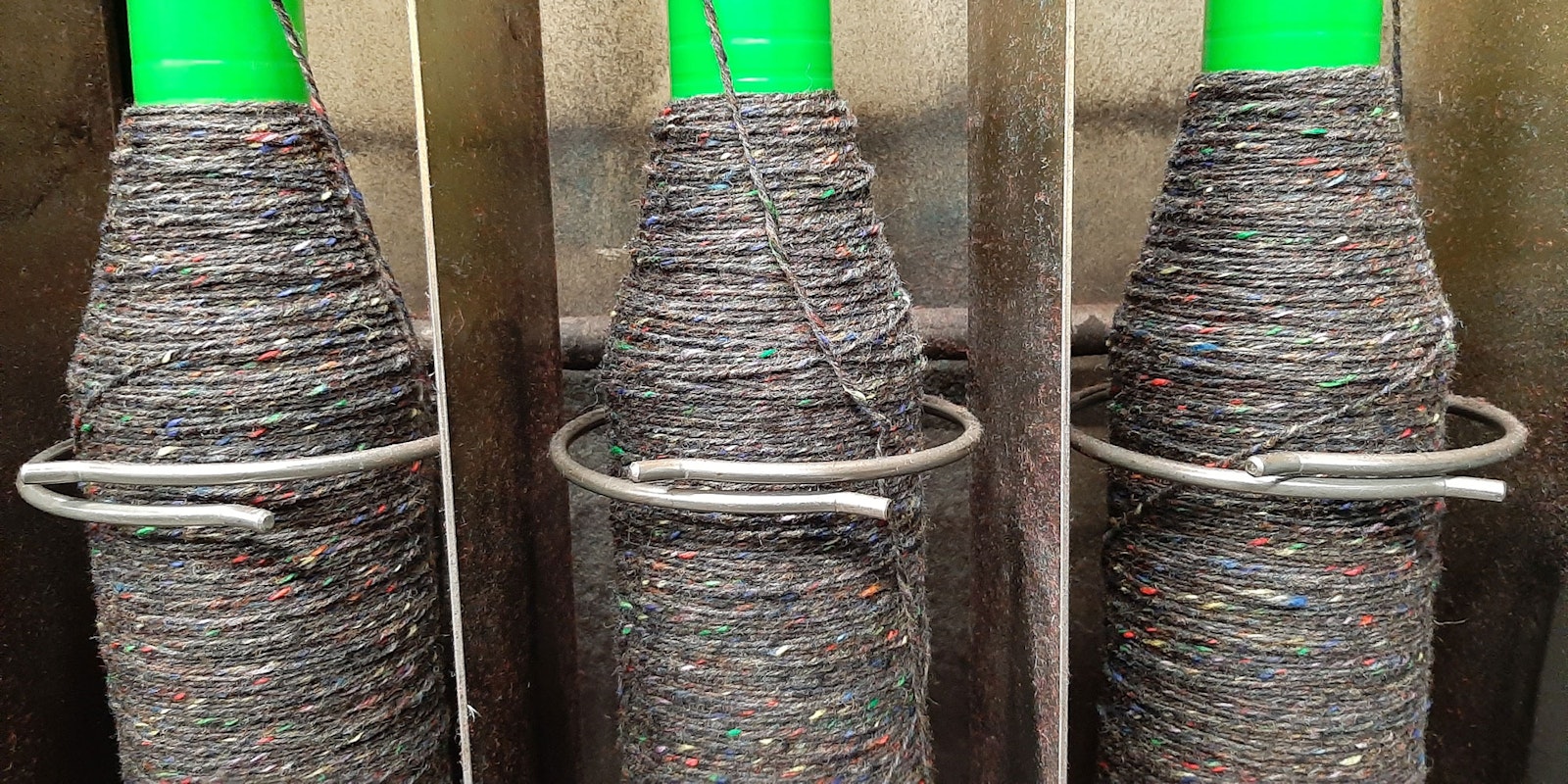My husband and I had a wonderful opportunity to visit the historic wool town of Ardara, the site of the old Donegal tweed markets and auctions, where we met Eddie Doherty in his brightly painted shop in the center of the village. His shop was filled with bolts of tweed and ready-made garments handwoven by Eddie himself or one of the weavers who work for him. Eddie, like other weavers and weaving studios in Donegal, still produces tweed on a fly-shuttle loom, pulling a handle above the beater that works a pulley system and sends the shuttle back and forth across the web.
In nearby Kilcar, we saw the actual dyeing and spinning of this unique yarn. We saw dyed wool hydraulically lifted from the pressurized dyebaths, run through drying machines, and then moved to the rooms where the colors are mixed with a vacuum blower.
 A worker in a Donegal tweed yarn mill rakes dyed fleece and flecks into an opening in the floor to begin the blending process. Photo provided by Studio Donegal
A worker in a Donegal tweed yarn mill rakes dyed fleece and flecks into an opening in the floor to begin the blending process. Photo provided by Studio Donegal
The blending process was incredible to watch: a worker raked dyed fleece and flecks into an opening in the floor, replaced the cover, and switched on the blower. The fleece was blown up a tube to the ceiling of an adjoining room, where a fan with two large padded arms helped to break up the clumps. It looked like a rainstorm of colored fleece! Next, the fleece went to a nearby machine that further dispersed and mixed the colors. The colors are blended just enough but not fully homogenized, as this is part of the depth and beauty of the yarn.
The fleece and flecks are carded and processed into rolls of pencil roving, which is taken to the ring-spinning frames. Once spun, the yarn is skeined or wound on cones as singles, or it is plied and then skeined or coned.
 Blending tweed flecks into solid-colored or heathered roving adds harmony to the colors of tweed and stabilizes the yarn fibers for spinning into yarn. Photo provided by Studio Donegal
Blending tweed flecks into solid-colored or heathered roving adds harmony to the colors of tweed and stabilizes the yarn fibers for spinning into yarn. Photo provided by Studio Donegal
The most inspiring part of our tour was meeting Nora McFadden, who “does the colours” for Donegal Yarns. Nora took us to her studio, where she has a desk with a hutch full of cubbyholes that hold small boxes, each labeled with the color code of the dyed fleece and dyed flecks that are her palette. She gave us a demonstration of her method. She pulled out and weighed a selection of three to four colors of fleece and flecks, creating a combination that totaled 100 grams, carefully noting the weight of each color component to record the recipe for this particular heathered color.
She roughly mixed the fleece combination with her hands, pulling at the fleece to begin the blending. Nora then carded the fleece combo and finally added the flecks and gave a few more strokes with the handcards to create a small batt. She spun a short sample off the point of an old mill bobbin winder.
At this point, if she is pleased with the color combination, she will also wet and felt a small sample of the batt. The recipe is written out on a sheet of paper, and the yarn sample and felted sample are attached to the sheet for future reference. This recipe for a 100-gram sample can then be multiplied to produce commercial-size runs of yarn.
A quiet, self-effacing woman, Nora McFadden clearly has a passion for color and is gifted with a natural eye for selecting and blending these shades. She asked us for our favorite color and told us that she loves purple. Nora also showed us a range of yarn colors based on local flowers and plants, illustrating how inspired she is by everything she sees around her in the Donegal landscape.
Thanks to Kokomo Yarns, distributors of Studio Donegal Yarns, for their assistance with this article.
An earlier version of this article appeared in Spin Off Summer 2019.
Melissa Weaver Dunning is a traditional handweaver and spinner who focuses on tartan and eighteenth-century home-produced textiles. She carries on this rich, storied tradition in her own teaching, sharing her passion for wool and linen.

